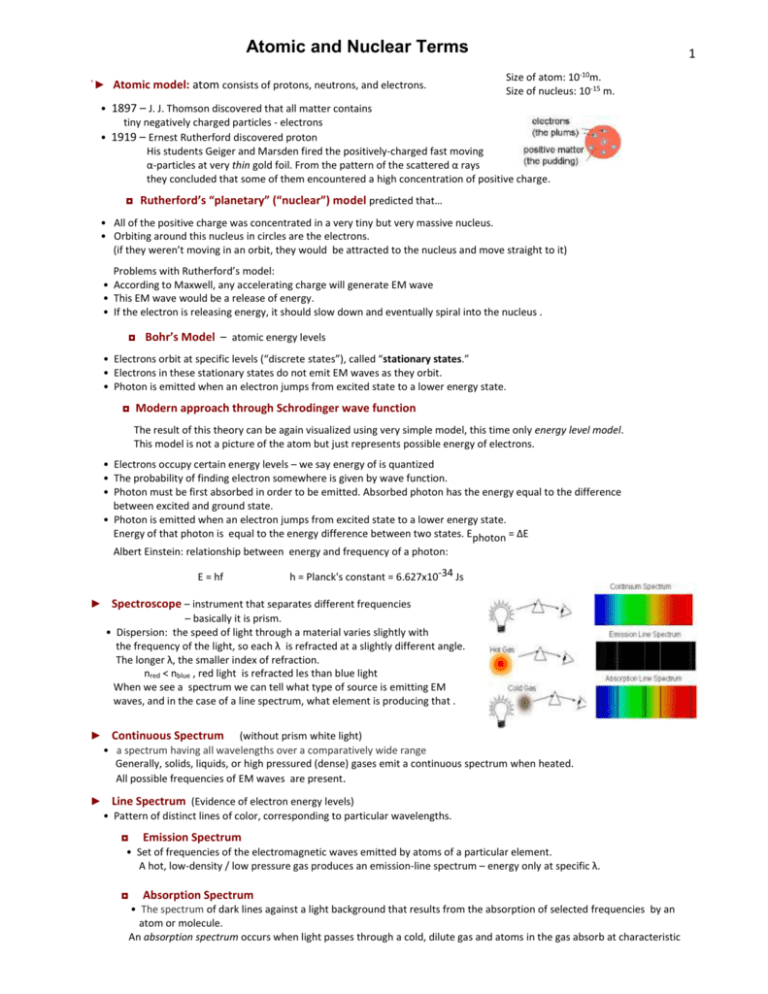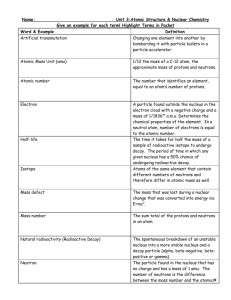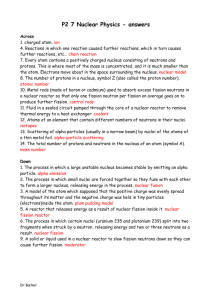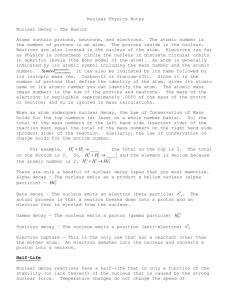Atomic and Nuclear Terms
advertisement

Atomic and Nuclear Terms `► Atomic model: atom consists of protons, neutrons, and electrons. 1 Size of atom: 10-10m. Size of nucleus: 10-15 m. • 1897 – J. J. Thomson discovered that all matter contains tiny negatively charged particles - electrons • 1919 – Ernest Rutherford discovered proton His students Geiger and Marsden fired the positively-charged fast moving α-particles at very thin gold foil. From the pattern of the scattered α rays they concluded that some of them encountered a high concentration of positive charge. ◘ Rutherford’s “planetary” (“nuclear”) model predicted that… • All of the positive charge was concentrated in a very tiny but very massive nucleus. • Orbiting around this nucleus in circles are the electrons. (if they weren’t moving in an orbit, they would be attracted to the nucleus and move straight to it) Problems with Rutherford’s model: • According to Maxwell, any accelerating charge will generate EM wave • This EM wave would be a release of energy. • If the electron is releasing energy, it should slow down and eventually spiral into the nucleus . ◘ Bohr’s Model – atomic energy levels • Electrons orbit at specific levels (“discrete states”), called “stationary states.” • Electrons in these stationary states do not emit EM waves as they orbit. • Photon is emitted when an electron jumps from excited state to a lower energy state. ◘ Modern approach through Schrodinger wave function The result of this theory can be again visualized using very simple model, this time only energy level model. This model is not a picture of the atom but just represents possible energy of electrons. • Electrons occupy certain energy levels – we say energy of is quantized • The probability of finding electron somewhere is given by wave function. • Photon must be first absorbed in order to be emitted. Absorbed photon has the energy equal to the difference between excited and ground state. • Photon is emitted when an electron jumps from excited state to a lower energy state. Energy of that photon is equal to the energy difference between two states. Ephoton = ΔE Albert Einstein: relationship between energy and frequency of a photon: E = hf h = Planck's constant = 6.627x10-34 Js ► Spectroscope – instrument that separates different frequencies – basically it is prism. • Dispersion: the speed of light through a material varies slightly with the frequency of the light, so each λ is refracted at a slightly different angle. The longer λ, the smaller index of refraction. nred < nblue , red light is refracted les than blue light When we see a spectrum we can tell what type of source is emitting EM waves, and in the case of a line spectrum, what element is producing that . ► Continuous Spectrum (without prism white light) • a spectrum having all wavelengths over a comparatively wide range Generally, solids, liquids, or high pressured (dense) gases emit a continuous spectrum when heated. All possible frequencies of EM waves are present. ► Line Spectrum (Evidence of electron energy levels) • Pattern of distinct lines of color, corresponding to particular wavelengths. ◘ Emission Spectrum • Set of frequencies of the electromagnetic waves emitted by atoms of a particular element. A hot, low-density / low pressure gas produces an emission-line spectrum – energy only at specific λ. ◘ Absorption Spectrum • The spectrum of dark lines against a light background that results from the absorption of selected frequencies by an atom or molecule. An absorption spectrum occurs when light passes through a cold, dilute gas and atoms in the gas absorb at characteristic 2 frequencies; since the re-emitted light is unlikely to be emitted in the same direction as the absorbed photon, this gives rise to dark lines (absence of light) in the spectrum. ► Nucleons: what protons and neutrons are collectively called. (practically all of the mass in the atom because electrons are so small) ► Nuclide – A particular combination of protons and neutrons that form a nucleus. It is used to distinguish isotopes among nuclei. ► Atom – the smallest amount of an element having the chemical properties of the element ► Isotopes – Nuclei (atoms) with the same number of protons and different numbers of neutrons. The existence of isotopes is evidence for the existence of neutrons the same number of electrons – the same chemical properties different number of neutrons → different masses – different physical properties A Z X Z is the atomic number = number of electrons or protons A is the nucleon (mass) number = number of neutrons + protons A – Z = number of neutrons ► Strong Nuclear Force – (official) The force that holds the particles of the nucleus together which acts only over short distances about 1.5 radii of a proton or neutron) and is independent of charge. • Nuclear Stability: depends on the number of neutrons present. • Nuclei are held together by a strong nuclear force, which counteracts the repulsive force among protons contained within it. As long as the attractive nuclear forces between all nucleons win over the repulsive Coulomb forces between the protons the nucleus is stable. It happens as long as the number of protons is not too high. Atomic nuclei are stable subject to the condition that they contain an adequate number of neutrons, in order to "dilute" the concentration of positive charges brought about by the protons ♦ Small nuclei- tend to have equal number of neutrons and protons ♦ Large nuclei- tend to have more neutrons to counterbalance repulsive Coulomb force The most massive isotope found in nature is uranium isotope 238 . 92 U For more massive nuclei strong nuclear force can’t overcome electric repulsion. ► Nuclear Reactions – A reaction that occurs whenever the number of protons or neutrons changes. • Nuclear reactions include natural and artificial transmutation, fission, and fusion. ► Transmutation – Nuclear change of one element into another. • In natural transmutations the nucleus decays spontaneously. There is only one nucleus that undergoes the transformation. • artificial transmutation is induced by the bombardment of the nucleus by high-energy particles. • In order to balance nuclear reaction the total mass and total charge number of the reactants has to equal the total mass and total charge number of the products. ► Radioisotope – an isotope of an element that is radioactive ► Radioactive Dating – Method of estimating the age of an object based on the object’s half-life and the amount of isotope present. Carbon dating is limited to the dating of organic (once living) materials. ► (Artificial) Radioactivity – The (induced) spontaneous breakdown of atomic nucleus with emission of particles and rays. ► Radioactive Decay – Spontaneous decay of unstable nuclei. This is a random process on the atomic level, in that it is impossible to predict when a particular atom will decay, but given a large number of similar atoms, the decay rate, on average, is predictable. • three common radiations - alpha, beta, gamma They differ in charge, ionization and penetration power. 3 ► α – Alpha Particle: 4 2 He Helium – 4 nucleus consisting of 2 protons and 2 neutrons, when emitted from the nucleus of a radioactive atom. ► α – Alpha Decay - A process that emits an alpha particle • the most ionizing and therefore the least penetrating • nucleus ejects an α particle, the atomic number is decreased by two and the atomic mass is decreased by four. 𝐴 𝑍𝑋 → 𝐴−4 𝑍−2𝑌 + 42𝛼 • α decay occurs primarily among heavy elements because the nucleus has too many protons which cause excessive repulsion. In an attempt to reduce the repulsion, a helium nucleus is emitted. 226 88 Ra 222 86 Rn 42 He Mass of parent > mass of daughter + mass of alpha Difference = kinetic β – Beta Particle – High speed electron emitted from the nucleus of aenergy radioactive atom ► β – Beta Decay – Process in which an electron (beta particle) and an antineutrino are spontaneously emitted from the nucleus. 𝐴 𝑍𝑋 𝑛 0 → 𝑝+ + 𝑒 − + 𝜈 → 𝐴 𝑍+1𝑌 + 0 −1𝑒 +𝜈 • this is the most common decay • occurs when the neutron to proton ratio is too great in the nucleus and causes instability. A neutron decays into a proton, electron and an antineutrino. The β particle and antineutrino are ejected from the atom entirely, and the proton remains in the nucleus. C 147 N 14 6 ► 𝜷+ Beta “+” Decay – Process in which a positron (beta “+” particle) and neutrino are spontaneously emitted from the nucleus. 𝑝+ → 𝑛 0 + 𝑒 + + 𝜈 𝐴 𝑍𝑋 → 𝐴 𝑍−1𝑌 + 0 +1𝑒 +𝜈 • A proton (decays) is converted into neutron while releasing a positron and neutrino. Positron emission is mediated by the weak force. • The 𝛽 + particle and neutrino are ejected from the atom entirely, and the neutron remains 23 12𝑀𝑔 ► → 23 11𝑁𝑎 + 𝛽+ + 𝜈 𝛽+ = 𝑒 + γ - Gamma Ray – High-energy photon emitted from the nucleus of a radioactive atom ► γ - Gamma Decay – Process in which a nucleus in an excited state drops to a lower energy state emitting gamma particle. • • most penetrating, the least ionizing the nucleus has less energy (it is more stable) but its mass number and its atomic number have not changed. 12 5 B 126 C * 0 1 e 126 C ► Stability – • If you plot the neutron number N against the proton number Z for all the known nuclides, you get the diagram shown here • The stable nuclides of the lighter elements have approximately equal numbers of protons and neutrons? • However, as Z increases the `stability line' curves upwards. • Heavier nuclei need more and more neutrons to be stable. • Can we explain why? ● It is the strong nuclear force that holds the nucleons together, but this is a very short range force. ● The repulsive electric force between the protons is a longer range force. ● So in a large nucleus all the protons repel each other, but each nucleon attracts only its nearest neighbours. More neutrons are needed to hold the nucleus together (although adding too many neutrons can also cause instability). There is an upper limit to the size of a stable nucleus; all the nuclides with Z higher than 83 are unstable. 0 1 e 4 ► Half – life (T1/2) is the time taken for one half of the nuclei present in any given radioactive sample to decay. • sample containing N radioactive atoms, grams, kilograms, moles,… after T/2 N/2 decayed after T/2 N/2/2 decayed after T/2 N/2/2/2 decayed … N survived, and N N N N N 15 after 4 T time, only + 2 + 3 + 4 = N - 4 = N 4 2 2 2 2 2 2 16 2 transmutated ► Activity (becquerel - Bq) of a radioactive sample is the average number of disintegrations per second. • It is much easier to measure the radiation than number of undecayed nuclei in a sample. • 100 Bq means that 100 nuclei are disintegrating/sec. As the activity is always proportional to the number of undecayed nuclei, it too halves every 8 days. Since the rate of decay is proportional to the number of nuclei, a graph of the rate of particle emission against time will have the same shape. ► Unified Atomic Mass Unit (u) - 1/12 of the mass of one atom of carbon-12 (6p+6n+6e). • 1 u = 1.66056655 x 10-27 kg ► Mass Defect – difference in mass between the sum of the masses of the (free) nucleons from which nucleus was made and the actual mass of an atomic nucleus (nuclide). • Total mass of a nucleus < sum of masses of nucleons • mass defect = total mass of nucleons – mass of nucleus > 0 δ = Zmp + Nmn - Mnucleus • Remember that periodic tables give atomic masses not nuclear masses. To get nuclear masses you have to subtract the masses of electrons in the atom from atomic mass. ► Binding Energy – Energy that must be applied to a nucleus to break it up into separate, free particles • A bound system has a lower potential energy than its constituent parts; this is what keeps the system together. • nuclear binding energy: BE = δc2 (c = speed of light in vacuum; δ = mass defect) (kg m2/s2 = J) • easier way: first find mass defect in unified atomic mass units (u) and then knowing that 1 u of mass converts into 931.5 MeV, BE = δ x 931.5(MeV) • energy released in nuclear reaction is found the same way: first find mass difference Δm = LHS – RHS in u - units and then E = Δm x 931.5 (MeV) 5 ► Binding Energy per Nucleon - energy required to remove 1 nucleon from the nucleus • is roughly the binding energy divided by total number of nucleons • The binding energy of a nucleus is a measure of how stable nucleus is. Greater mass defect – higher binding energy – greater stability. • Most nuclei have a binding energy per nucleon of approximately 8 MeV. ► Energy released in a decay - conservation of total energy (energy + mass). 226 88 Ra 222 86 Rn 4 2 M > m1 + m2 , but total energy on the left = total energy on the right Mc2 = m1 c2 + m2 c2 + KE1 + KE2 • spontaneous decay: M > m1 + m2 → binding energy of the decaying nucleus < binding energies of the product nuclei. This is why radioactive decay happens with heavy elements lying to the right of maximum in the binding energy curve. Energy released is in the form of kinetic energy of the products. ► Energy released in a nuclear reaction/artificial transmutation • Nuclear reactions A + B → C + D can either release energy or requires energy input. • energy input: Nitrogen-14 will decay only if energy is supplied to it - collision with fast moving α particle: 18.0057 u < 18.0070 u Δm = (mA + mB) – (mC + mD) < 0 α particle must have enough KE to make up for imbalance in masses, and to provide for kinetic energy of products. • release energy: Energy will be released in nuclear reaction if Δm = (mA + mB) – (mC + mD) > 0 The total amount of energy released will be E = Δmc2 in the form of kinetic energy of products. If there was initial kinetic energy, that will be added up to released energy. ► Fission - means splitting up a large nucleus (A > 200) into two smaller nuclei, generally accompanied by the release of one or more neutrons and energy (as gamma rays and as kinetic energy of the fragments). • • • • • the total BE would increase which means that the daughters are more stable than parent (look at the graph). Fission can occur when a nucleus of a heavy atom captures a neutron, or it can happen spontaneously. Spontaneous fission is very rare. Uranium is the largest nucleus found on Earth. Its isotopes will sometimes fission naturally. But half-life for U-235 is 7.04x108 years. Bombarding the nucleus with neutrons can trigger a fission reaction. For example The strong forces that hold the nucleus together only act over a very short distance. When a uranium nucleus absorbs a neutron (U-235 → U-236) it knocks the nucleus out of shape. If the nucleus deforms enough, the electrostatic repulsion between the protons in each half becomes greater than the strong force. It then splits in two. The nuclei splits randomly. In the diagram, the fission fragments are shown as isotopes of Ba and Kr. This is just one of the many possible combinations. Fission of a uranium nucleus gives out about 200 MeV of energy. 6 Chain Reactions • When the uranium nucleus splits, a number of neutrons are also ejected. • If each ejected neutron causes another uranium nucleus to undergo fission, we get a chain reaction • The number of fissions increases rapidly and a huge amount of energy is released. • Uncontrolled chain reactions are used in nuclear bombs • The energy they unleash is devastating. • Nuclear power stations use the heat released in carefully controlled fission reactions to generate electricity. • They use control rods to absorb some of the neutrons. ► Fusion means joining up two small nuclei to form a bigger nucleus releasing great amounts of energy in the process • When two small nuclei the product of fusion would have more BE per nucleon. • The increases in binding energy per nucleon are much larger for fusion than for fission reactions, because the graph increases more steeply for light nuclei, so fusion gives out more energy per nucleon involved in the reaction than fission. • The stars are powered by fusion reactions. • Each second, in our Sun, more than 560 million tonnes of hydrogen fuse together to make helium. One series of reactions for this is shown here: Each small nucleus has a positive charge so they will repel each other. To make the nuclei come close enough for the strong force to pull them together, they must be thrown together with very high velocity. For this to take place, the matter must either be heated to temperatures as high as the core of the sun (about 13 million Kelvin) or the particles must be thrown together in a particle accelerator) • • • • • Fusion has a number of advantages over fission: greater power output per kilogram, the raw materials are cheap and readily available, no radioactive elements are produced directly, irradiation by the neutrons leads to radioactivity in the reactor materials but these have relatively short half lives and only need to be stored safely for a short time. ► Nuclear radiation and health α and β - particles have energies measured in MeV. To ionized an atom requires about 10 eV, so each particle can ionize 10 5 atoms before they have run out of energy. When radiation ionizes atoms that are part of a living cell, it can effect the ability of the cell to carry out its function or even cause the cell wall to be ruptured. If a large number of cells that are part of a vital organ are effected than this can lead to death. In minor cases the effect is similar to a burn. The amount of harm that radiation can cause is dependent on the number and energy of the particles. When a gamma photon is absorbed the whole photon is absorbed so one photon can ionize only one atom. However, the emitted electron has so much energy that it can ionize further atoms leading to damage similar to that caused by alpha and beta. • Very high dose: Can affect the central nervous system leading to loss of coordination and death within two or three days. • Medium dose can damage the stomach and intestines resulting in sickness and diarrhea, and possibly death within weeks. • Low dose: Loss of hair, bleeding, and diarrhea. • Safe dose: All ionizing radiation is potentially harmful, so there is no point below which it becomes totally safe. However, at very low levels the risk is small, and can be outweighed by the benefits gained when, for example, an x-ray is taken of a broken leg. • Long-term: There is some evidence that after exposure to radiation, the probability of getting cancer or having a child with a genetic mutation increases. • Cancer: Rapidly dividing cancer cells are very susceptible to the effects of radiation and are more easily killed than normal cells. In radiotherapy, nuclear ratiation is used to cure cancer by killing the cancerous cells. • ► Protection against radiation There are two ways we can reduce the affect of nuclear radiation: distance and shielding. Alpha and beta radiation have a very short range in air, so will not be dangerous a few meters away from the source. The number of gama photons decreases proportional to 1/r2 (where r is the distance from the source), so the further away you are, the safer you will be. Although alpha is the most ionizing radiation, it can be stopped by a sheet of paper (although that means that alpha is the most harmful if ingested). Beta and gamma are more penetrating, so need a thick lead shield to provide protection.








